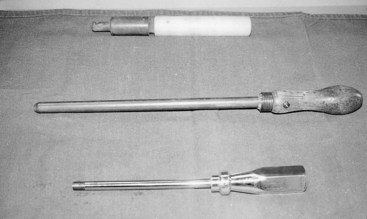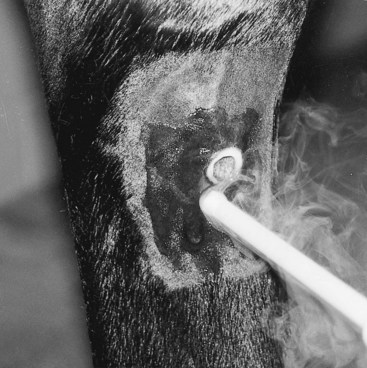Chapter 89Cryotherapy
Cryotherapy has been used widely in veterinary medicine since the 1970s, primarily for tumor ablation. Percutaneous cryotherapy, called freeze firing or freezing, is a useful palliative technique for various musculoskeletal disorders in the horse, but little research has been published on specific techniques or results.1-4 Most of the information in this chapter comes from our clinical experience using cryotherapy to manage selected lameness conditions. Cryotherapy generally is used for pain management, and our recommendations are made assuming the horse will continue or resume athletic performance. The term cryotherapy (cold therapy) is sometimes used to refer to intentional cooling of a body part to reduce inflammation or the effects of inflammatory mediators. For instance, cryotherapy is used to prevent laminitis by inducing digital vasoconstriction (see Chapter 34).
Basic Technique
Cryotherapy instruments and cryogens are described elsewhere, and only basic principles are discussed here.7-9 Instruments used to apply cryogens vary from simple cryoprobes to cryounits with continuous closed-system flow of cryogen liquid. We use liquid nitrogen that is stored in a commercial 10- to 20-L tank. For all techniques we use individual brass probes, 1.5 cm in diameter (Figure 89-1), precooled in liquid nitrogen and positioned on the lesions for a double freeze-thaw cycle consisting of freezing (60 seconds), thawing (60 seconds), and freezing (60 seconds). Local edema formation is minimal and has no effect on the second freezing cycle. Earlier work suggested that a thaw duration of 15 seconds was optimal, but our modified cycle appears effective.4 We prefer to use solid metal probes, because consistent freezing to a specific depth is easy to control (Figure 89-2). The cooling ability of solid metal probes has been questioned, but in one study solid metal probes were most effective in freezing to specific depths.7
Stay updated, free articles. Join our Telegram channel

Full access? Get Clinical Tree




